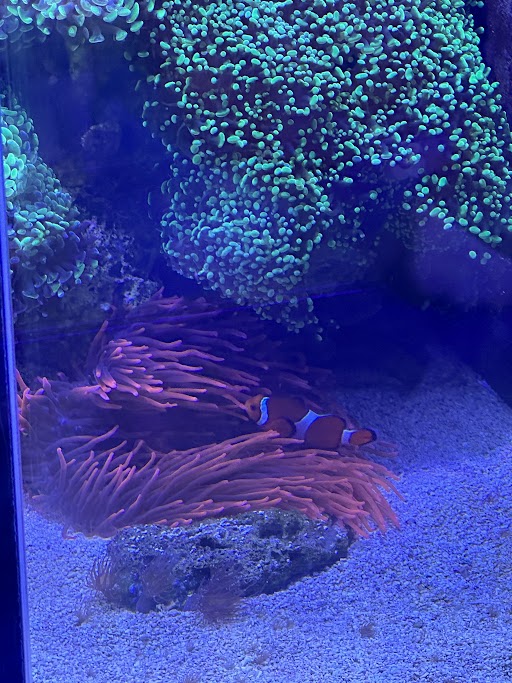Event: Field Trip to the Smithsonian National Zoological Park

Picture of a clownfish in the coral lab within the science gallery
Event time and place:
SGC field trip in Washington D.C
Date: 05/05/24
Tour/Hall #1: Self-Guided (Birdhouse)
1) What information is listed for each species?
- where it is native to (for example, ducks from the prairie pothole region)
- some include information about migration (for example, some migrate from south america to canada for warmer climates)
- diet of different birds
2)
List at least four (4) species that are on display
- Ruddy Duck
- Northern Shoveler
- Band-tailed pigeon
- Black-Throated Blue Warbler
- Barred owl
3) If any, what types of displays that go beyond simple identifying text on a panel are available in this building? (These might be interactive displays, videos, skeletons, or others.) Did you find them to be informative?
- displayed a menu for the birds you can flip through that show different varieties of what they eat
I found this interactive informative and fun as it educated me on different bird diets while making it engaging

Description of different fish in the Electric Fishes interactive exhibit
Elementary/Middle school as the language is simple, easy to understand, and has multiple interactions that younger kids might find interesting.
5)Whether or not you see if any non-SGCer is actually paying attention to the information plaques and/or interactive displays
Yes, many were reading the boards and displays
____________________________________________________________________
Tour/Hall #2: Merck (Amazonia)
1) What information is listed for each species?
- information about endangerment and extinction for some species (such as the amazonian ray, which is threatened by the trade in ornamental fish)
- background info such as their name and where they are from, example being the guinea pig, which is known as the cavia porcellus and is from south america)
2)
List at least four (4) species that are on display
- Amazonian rays
- Electric eels
- Blunt Nose Knifefish
- Red Phantom Tetra
- Grey Leporacanthicus
3) If any, what types of displays that go beyond simple identifying text on a panel are available in this building? (These might be interactive displays, videos, skeletons, or others.) Did you find them to be informative?
- touching eel structure that gives users information about eels and how they are like living batteries with positive heads and negative tails. The structure vibrates when you touch the head and the tail
I found this structure informative as it gave me a visualization of how the eel works

Caecilian tank that informs the watcher of what
the Caecilian is, while letting them see it in real life!
Elementary/middle school since it is interactive and information is easy to understand.
5)Whether or not you see if any non-SGCer is actually paying attention to the information plaques and/or interactive displays
Yes, people were engaging with the interactives and were taking a look at the informative plaques.
__________________________________________________________________
EDUCATION
Additionally, zoos are major centers for education about zoological and ecological issues. Find and describe two (2) specific examples of ways that the Zoo aids in the public understanding of animals and ecosystems OTHER THAN simple plaques with printed information
- tour guide/specialists who help guests and provide information about the exhibit (for example there was one at the duck section of the bird hall)
- addition of different wallpapers to visualize where the animal is from and its ecosystem
__________________________________________________________________
ANIMAL MENTAL/EMOTIONAL WELFARE
Face it: zoo animals are kept in captivity, and for many animals this is a potentially traumatic experience. These animals evolved in the wild, and their behaviors are adapted to living in the more complex (and simply BIGGER) world outside.
In the old days the mental or emotional welfare of the exhibit animals were not of primary concern: just stick them in a cage for all to see. But this attitude has changed.
Find at least two (2) specific examples where either the physical setting or objects in their environment have been added to provide a more interesting or comfortable place for the animals.
- flowers and plants added to the area in which the animal resides in the amazonia exhibit.
- wallpapers on the walls that mimic certain areas/places to make the animal feel more at home in the bird house exhibit (EX: beach wallpaper where aquatic animals were living).


